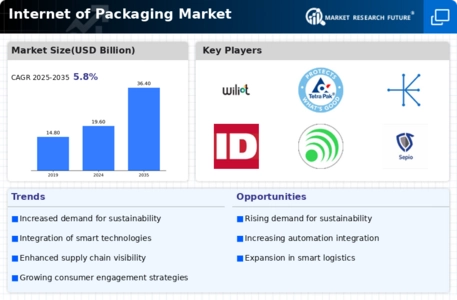Market Trends
Key Emerging Trends in the Internet of Packaging Market
The Internet of Packaging (IoP) market has seen notable trends lately, which demonstrate how digital technologies are increasingly being integrated into traditional packaging solutions. One such trend is the growing use of intelligent packaging, which exploits Internet of Things (IoT) capacities such as network connections for improving product visibility and customer engagement. It also incorporates sensors together with other connectivity features, enabling manufacturers and customers to follow different stages or phases during a product's lifecycle. Furthermore, sustainability has emerged as one major theme across IoP markets. As consumers become more environmentally aware, both individuals and governments are demanding eco-friendly forms of package design. Smart packaging developed using Internet of Things technology contributes towards waste reduction by encouraging reusing or recycling products through improved recycling programs. Temperature monitoring prevents spoilage while reducing unnecessary wrapping, leading to "smart" packages that contribute to a greener supply chain. Additionally, AR and VR applications have started making their way into packaging materials. A number of businesses have adopted virtual reality technology to enhance user experience or develop interactive packaging besides just consuming them. With this feature, a product becomes enjoyable and interactive as well as giving the brand an opportunity to share more information or even personalized content with customers through their packaging. Blockchain is also being used in IoP applications that aim to address issues of traceability and transparency. Through blockchain, every transaction in the supply chain is recorded securely so that consumers can know where a given product comes from and tell if it is authentic. Moreover, the growth of e-commerce has led to the development of new IoP solutions targeting online retailers. Smart packages have become crucial for ensuring products are delivered without tampering during transportation by incorporating functionalities such as real-time location tracking or temperature control. The Covid-19 pandemic, on its part, has had some impact on IoP trends, thus fast-tracking the adoption of non-contact and touch-free packaging options. Because of concerns over contamination, there is growing interest in technologies like antimicrobial coatings for packaging surfaces and no-touch opening devices. This behavioral change among consumers has compelled the packaging industry to focus more on materials innovation and design to meet the changing needs of the post-pandemic era.


 Source: Secondary Research, Primary Research, Market Research Future Database and Analyst Review
Source: Secondary Research, Primary Research, Market Research Future Database and Analyst Review









Leave a Comment